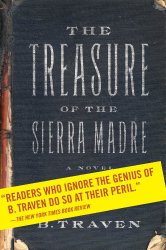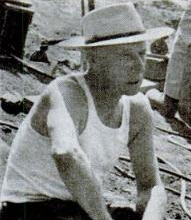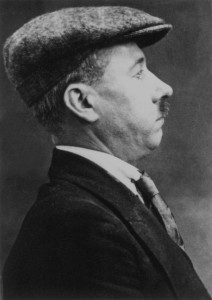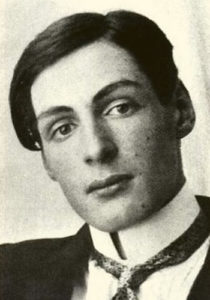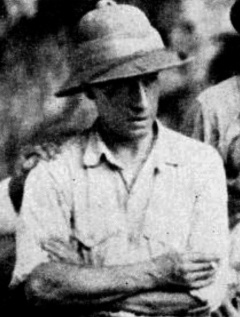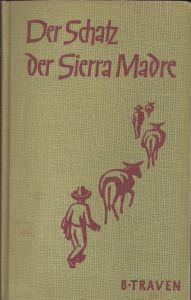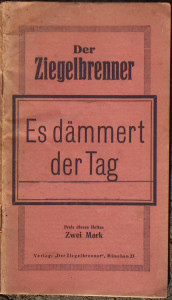More information about the “Twenty Writers, Twenty Books” project may be found at the “Twenty Writers” home page
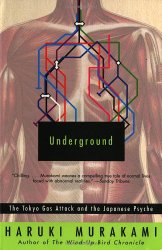 Haruki Murakami is the enviable writer who has become a canon unto himself. Murakami is often compared to many different authors—Kafka, Carver, Brautigan—but the list is so diverse it’s difficult to pigeonhole his body of work as one style or another. Just about everyone I know has a favorite Murakami book, usually Kafka on the Shore or The Wind-up Bird Chronicles.
Haruki Murakami is the enviable writer who has become a canon unto himself. Murakami is often compared to many different authors—Kafka, Carver, Brautigan—but the list is so diverse it’s difficult to pigeonhole his body of work as one style or another. Just about everyone I know has a favorite Murakami book, usually Kafka on the Shore or The Wind-up Bird Chronicles.
I’ve read only two of his fictions. The first, Hard-boiled Wonderland and the End of the World, was not nearly as hard-boiled as the title suggests and not nearly as cyberpunk as the book blurbs led me to believe. The other was After the Quake, a short story collection I consumed in Japanese ryokans and on train rides between Osaka, Kyoto, and Hiroshima. It too left me cool. It was After the Quake that led me to understand why Murakami is so often compared to Raymond Carver. His stories were of “average” people in modest circumstances pushing back ever-so-lightly on pressure applied, all told in unadventurous language. Quiet conversations around beach campfires and characters wandering city parks recalling painful memories are the norm in After the Quake. It’s hardly fair for me judge his work as a whole from these two books, but they left me scratching my head wondering about his glowing reputation.
Underground: The Tokyo Gas Attack and the Japanese Psyche changed that. The book is brilliant in its foundation: Give the victims of the 1995 Tokyo subway sarin attacks an opportunity to tell their stories of that crazed rush-hour morning. Murakami the novelist takes his hand off the rudder and lets those victimized assume control of the conversation, and the results are gripping. Thirty-two victims, mostly commuters and subway workers, discuss the morning’s events and the aftereffects of exposure to the nerve agent. More importantly, they reveal (sometimes subconsciously) their attitudes toward work & career, family & friends—and their country.
It’s a backhanded compliment to tell a fiction writer that his best work is a collection of interviews, but as any journalist knows, writing an interview is not merely recording what was said, it’s shaping what was said. Murakami may be the best writer imaginable to shape these stories and present them internationally. A Japanese native conversant in Western-style writing, he’d lived abroad for nine years before returning home to interview the sarin gas victims. From studying Murakami’s biography and reading his comments in Underground as the interviews unfold, Murakami was obviously attempting to come to grips with the mentality of his countrymen as well as the attackers, the Aum Shinrikyo, a Japanese cult led by self-described Christ-figure with political ambitions.
It’s one of the real strengths of Underground that the author finds himself questioning his cultural and social affinities when by all rights he should in a comfort zone no non-Japanese could claim. Murakami speaks the language, he was educated in the same educational system, he was raised on the same cultural and media diet. Murakami knows the unwritten norms of Japan, yet he is as amazed as any gaijin about the interviewees daily schedules, perceptions, and reactions to the attacks.
Books about foreign lands tend to enjoy a boost from the exoticism of it all: different food, misunderstood customs, language troubles, the country’s history as backstory. The exoticism in Underground is different. It’s like humanistic science-fiction or the work of Borges, where alien norms and mores are treated as everyday and commonplace by the characters and the narrator, leaving the reader to tease out the logic of an alternate universe. It’s the tingle of decoding what’s really being said, of detecting what’s being alluded to and what has been elided, that makes Underground an open rather than a closed text.
“A grumble under the breath”
In Underground‘s preface, Murakami relates that some time after the attacks he was flipping through a Japanese popular magazine when his attention was caught by a letter on the letters-to-the-editor page:
It was from a woman whose husband had lost his job because of the Tokyo gas attack. A subway commuter, he had been unfortunate enough to be on his way to work in one of the cars in which the sarin gas was released. He passed out and was taken to hospital. But even after several days’ recuperation, the aftereffects lingered on, and he couldn’t get himself back into the working routine. At first, he was tolerated, but as time went on his boss and colleagues began to make snide remarks. Unable to bear the icy atmosphere any longer, feeling almost forced out, he resigned.
…As far as I can recall, there was nothing particularly plaintive about [the letter], nor was it any angry rant. If anything, it was barely audible, a grumble under the breath.
Like a well-crafted novel, this opening grumble (and Murakami’s reaction to it) foreshadows almost everything that is to follow.
First, it’s difficult to imagine this work situation being tolerated in the United States—it sounds like grounds for a lawsuit, one that many tort-minded Americans would be happy to pursue. There’s not a hint here of such thinking. Then there’s the letter-writer herself, the wife now emotionally shredded by the double-blow of a bizarre physical assault on her husband followed by the isolation by her husband’s work unit. If the perception of Japan is one of efficient and cohesive group dynamics, how did this family wind up in this situation?
And then there’s Murakami’s reaction: equal parts confusion, despair, and frustration. As a native Japanese speaker, he detected the grumble from language nuances I suspect an outsider might not have noticed. But that’s as far as his insider status allows him inside. Like Valentine in Heinlein’s Stranger in a Strange Land, Murakami is the alien who returns to his birthplace unable to recognize the land from which he sprung.
This barely audible grumble was the impetus for Murakami to interview the victims of the Tokyo subway attacks, and so Underground is as much a way for Murakami to understand his own country as it is to explain it to those outside of Japan, us gaijin. Murakami also designed Underground as a mirror for him to hold up to his countrymen and ask them to consider fully the way of life they’d carved out for themselves. How successful that enterprise has been, I do not know, but I am not optimistic.
Working
There was one other element of the preface that captured my attention. It’s in a footnote that’s literally attached to the word “Preface” at the top of the page:
I would like to make clear that I borrowed useful ideas toward the composition of this book from the works of Studs Terkel and Bob Greene.
 I’m unfamiliar with the work of Bob Greene but I’m very much a fan of Studs Terkel, in particular a book of interviews he wrote in the early 1970s called Working. Unlike Underground, where Murakami’s subjects are intertwined by a single defining event, Terkel’s subjects in Working have only the most meager of commonalities: they live in America and they are employed (and for some, not even formally employed). Studs Terkel interviewed more than one hundred people of all walks. His interviews resound of the the old-fashioned joy of a sportswriter in the baseball bleachers alongside dockworkers and plumbers gathering their expert opinions of the game for his next article. Terkel’s ability to capture natural language and paint it on the page is legendary, and Working is his masterpiece toward that end.
I’m unfamiliar with the work of Bob Greene but I’m very much a fan of Studs Terkel, in particular a book of interviews he wrote in the early 1970s called Working. Unlike Underground, where Murakami’s subjects are intertwined by a single defining event, Terkel’s subjects in Working have only the most meager of commonalities: they live in America and they are employed (and for some, not even formally employed). Studs Terkel interviewed more than one hundred people of all walks. His interviews resound of the the old-fashioned joy of a sportswriter in the baseball bleachers alongside dockworkers and plumbers gathering their expert opinions of the game for his next article. Terkel’s ability to capture natural language and paint it on the page is legendary, and Working is his masterpiece toward that end.
Terkel documented the travails and mundanity of employment as a hotel doorman, a strip miner, a receptionist, a cabbie. Pauline Kael is interviewed here, as is Rip Torn, jazz musician Bud Freeman, and a handful of sports figures. Otherwise, the remaining 130-odd people are not those who would be called “of note” although they are now immortalized in this classic of American journalism. (Fortuitously, as I was writing this post Longform reprinted a selection from Working on their web site.)
For me, a fiction writer, Working is a kind of master class on capturing attitude and character through voice, of revealing psyche and spinning out personality on the page in a flowing, natural manner. Any class on first-person narrative should be reading from this book. Terkel records so much more than the words of his interview subjects, he preserves their essence in a way that captivates rather than categorizes, much like Quincy Troupe‘s masterful preservation of Miles Davis and his voice.
Terkel is beautifully invisible in Working. In the interviews themselves he’s barely present. Whole pages of confessions and revelations emerge from his subjects without a single question or prompt from Terkel himself. Of course this is not how interviews pan out—people rarely talk openly and cogently about a single subject, unprepared, for two hours. Given free reign, most people will talk themselves into mundane subject matter and personal minutia, like water seeking the path of least resistance. Terkel stitched together what must’ve been numerous false starts and meandering discussions into pitch-perfect exegeses on the nature of life as a farm worker, a desk receptionist, a realtor, an auditor, and so on.
Studs Terkel proves the American language as practiced is unique, controlled but not stiff, and perhaps most vital of all, so very tied to our professions. In other parts of the world people identify with their family and their family name, the town they came from, the place they were born, the religion they were raised in. In America, people identify by their jobs. It’s why when Americans first meet we ask each other “What do you do?” Working is almost encyclopedic on the subject, categorizing subjects by their fields (“Working the Land”, “Communications”, “Brokers”, “Bureaucracy”) as well as their positions in society (“In Charge”, “Cradle to Grave”, and perhaps reflective of the rise of feminism at the time, “Just a Housewife”, a section featuring two women who are so much more than housewives). The book’s organization is democratic and pluralistic, just like the society Studs Terkel himself strove to see America progress toward.
Working is the kind of book you can dip into randomly, just flip to a page and start reading. Here’s Terry Mason, an airline stewardess:
We had to go to stew school for five weeks. We’d go through a whole week of make-up and poise. I didn’t like this. They make you feel like you’ve never been out in public. They showed you how to smoke a cigarette, when to smoke a cigarette, how to look at a man’s eyes. Our teacher, she had this idea we had to be sexy. One day in class she was showing us how to accept a light for a cigarette from a man and never blow it out. When he lights it, just look in his eyes. It was really funny, all the girls laughed.
…The idea is not to be too obvious about it. They don’t want you to look too forward. That’s the whole thing, being a lady but still giving out that womanly appeal, like the body movement and the lips and the eyes. The guy’s supposed to look in your eyes. You could be a real mean woman. You’re a lady and doing all these evil things with your eyes.
This is why I react with suspicion when I read a contemporary American short story or novel of literary ambition that is praised for capturing the voice of the “average” American. Terry Mason is about as down-to-earth as I can imagine, but as the above selection reveals, she’s not dim or easily impressed by authority.
That’s often what I find in contemporary American fiction when the setting takes place outside of urban centers. A character watching an Olive Garden commercial in their McMansion arise from their barcalounger like a Manchurian Candidate, board their SUV or minivan, and drive to the nearest Olive Garden (flanked, as the author can’t resist, by a Chili’s and a Fresh Choice). They flatulantly squeeze their overweight body into the booth and order an absurdly large meal. Studs Terkel doesn’t need to supply his interview subjects with dignity. They already possess it.
The discussions often turn wonderfully philosophical. Vincent Maher, a police officer:
When I worked as a bartender, I felt like a non-person. I was actually nothing. I was a nobody going nowhere. I was in a state of limbo. I had no hopes, no dreams, no ups, no downs, nothing. Being a policeman gives me the challenge in life that I want. … I don’t think it’s necessary for a man to prove himself over and over and over again. I’m a policemen, win, lose, or draw.
This trifecta of occupation, identity, and one’s future is a core preoccupation with Terkel’s subjects. Barbara Terwilliger:
I really feel work is gorgeous. It’s the only thing you can depend upon in life. You can’t depend on love. Oh, love is quite ephemeral. Work has a dignity you can count on.
Terry Mason again:
A lot of stewardesses wanted to be models. The Tanya girl used to be a stewardess on our airline. A stewardess is what they could get and a model is what they couldn’t get. They weren’t the type of person, they weren’t that beautiful, they weren’t that thin. So their second choice would be stewardess.
What did you want to be?
I wanted to get out of Broken Bow, Nebraska. (Laughs.)
That’s the Midwestern honest-speaking that I’m familiar with. I’ll never forget a Minnesota cousin of mine working at the movie theater food concession one summer. Reflecting the exorbitant food prices, she called it the “chump counter.” It’s too bad Studs Terkel didn’t get a chance to interview her.
Underground
As joyful as I find Terkel’s Working, he makes it clear in his introduction that he does not view what follows as a celebration:
Something unreal. For me, it was a feeling that persisted throughout this adventure. (How else can I describe this undertaking? It was the daily experience of others, their private hurts, real and fancied, that I was probing. In lancing an especially obstinate boil, it is not the doctor who experiences the pain.)
Something similar is echoed by Murakami in his epilogue:
Eventually I stopped making judgments altogether. “Right” or “wrong,” “sane” or “sick,” “responsible” or “irresponsible”—these questions no longer mattered. At least, the final judgment was not mine to make, which made things easier. I could relax and simply take in people’s stories verbatim. … Especially after conducting interviews with the family of Mr. Eiji Wada—who died in Kodemmacho Station—and with Ms. “Shizuko Akashi”—who lost her memory and speech and is still in the hospital undergoing therapy—I had to seriously reconsider the value of my own writing.
What Working does not have that Underground has in spades is a nucleus of violence, sacrifice, and above all, lingering confusion. It’s why Underground at times reads like a suspense thriller, although one that twists your stomach rather than elevates the senses. There is no pleasure in reading about the station workers who, resolute the subway trains spend no more than sixty seconds unloading and loading passengers, get on their hands and knees to mop up the liquid sarin thinking it was some kind of spilled oil or paraffin.
The crime blotter details of the attack go like this: On the morning of Monday, March 20, 1995, five teams from the Aum Shinrikyo cult boarded separate Tokyo subway trains during rush hour. Each carried plastic bags of sarin, a nerve agent developed during World War II that is usually aerosolized and deployed in gas form. (Aum Shinrikyo had failed to perform this final step.) While in transit they punctured the bags and exited the trains, leaving the liquid sarin to spread on the floors and evaporate into an inhalant. Some 6,000 people were wounded, many permanently. Thirteen people died.
I recall the day of the sarin attacks; my first reaction was What—in Tokyo? Japan’s culture of security and safety is legendary to the point of absurdity. That these attacks could be orchestrated by a charismatic cult leader with grandiose political ambition, a man who’d attracted not only the poor but also academics and business leaders, sounded straight from the California playbook circa 1969 to 1979—Charles Manson, The Source Family, and Jim Jones all wrapped up in one. Even with my limited understand of Japanese culture, nothing of the attack’s reports in the American media sounded likely. When I spotted Murakami’s book I picked it up to satisfy this long-standing itch. I now feel like Murakami gave me so much more.
Unlike Working, Underground is not designed to be dipped into randomly. It’s important for the interviews to be read sequentially, evidence of Murakami’s hand guiding the narrative, if only loosely. The overall organization of the material does reflect Terkel’s strategy to some degree. Instead of consolidating interviews by jobs, Murkami groups the interviews by train lines and stations. Since the release of the sarin gas was more-or-less simultaneous across Tokyo, this might seem counterproductive to a writer attempting to shape a narrative out of these interviews, but Murakami sets the right stories in the right places to achieve some devastating effects.
 Beyond Murakami, the one work of Japanese literature most Americans are familiar with is Ryunosuke Akutagawa’s “Rashomon”, although that’s mostly due to Kurosawa’s film and not the story itself. What’s lesser-known is that the film is a commingling of two Akutagawa stories, “Rashomon” and “In a Grove”. The Rashomon effect is a partial misnomer; it’s “In a Grove” that regards the contradictions in multiple attestations of the same event. (There’s a kind of irony that the Rashomon effect’s misnaming is due to people learning the story secondhand.)
Beyond Murakami, the one work of Japanese literature most Americans are familiar with is Ryunosuke Akutagawa’s “Rashomon”, although that’s mostly due to Kurosawa’s film and not the story itself. What’s lesser-known is that the film is a commingling of two Akutagawa stories, “Rashomon” and “In a Grove”. The Rashomon effect is a partial misnomer; it’s “In a Grove” that regards the contradictions in multiple attestations of the same event. (There’s a kind of irony that the Rashomon effect’s misnaming is due to people learning the story secondhand.)
So it’s interesting to me that this misnamed effect is in play in Underground as well. The first interviewee, Kiyoka Izumi, offers in her story a broad on-the-ground retelling of the attack on the Chiyoda line and the resulting chaos. Izumi discovers difficulty breathing while en route to her job. When she emerges from the Kasumigaseki station she walks into the chaos of commuters passed out, gasping, blind and staggering for the exits—”‘hell’ describes it perfectly.” She leverages her prior experience as a Japan Railways (JR) employee to offer assistance with the trains and the sick. (By doing so she increased her exposure to the sarin gas.) Her opening interview is perhaps the perfect choice in terms of giving a matter-of-fact account of how the attack turned the station, and all of Tokyo, upside-down. She is also one of the more frank storytellers in the book, a Japanese who is acutely aware of her culture’s nuances and curiosities.
The Rashomon effect comes to play in the interviews which follow, as the very JR workers Izumi saw and coordinated with now tell their stories. Unlike “In a Grove”, where the conflicting accounts are unworkable toward puzzling together some kind of truth, these stories complement Izumi’s and flesh out further the morning’s events. To read four separate accounts of station attendant Takahashi’s death is particularly heartrending. Perhaps it’s a kind of rebuttal to Akutagawa that when four stories offer strong agreement, not just the truth but a greater truth begins to emerge.
With the basics laid down in these initial interviews, Murakami opens the book up to the other victims. Here Underground begins to feel more like Working in that we meet individuals from various backgrounds and livelihoods, not just the JR workers and TV crews descending on the spectacle. Often those interviewed in Underground sound as American as anyone in Working:
…we must make every effort to ensure that this prosperous and peaceful nation, built on the labors of previous generations, is preserved and passed on for generations to come. … I can’t see any future for Japan if we blindly persist with today’s materialistic pursuits.
Here Kozo Ishino is joining a broader discussion in modern Japan, a caution that has been expressed from as diverse figures as the Heisei royal family to Hiroo Onoda, the World War II army officer who lived in the Philippine bush for thirty years fighting a war long over. And then Ishino admits:
I’ve just turned 40 and up to now I’ve been living carelessly. It’s about time I took control of myself, gave some deep thought to my own life. … I’ve been concentrating on my career all these years, so I’ve never known real fear.
These words would have found in a comfortable home in Terkel’s Working, where so many of his interviewees are surprisingly philosophical about their lot in life.
“To the spirit as well as to the body”
Murakami bravely admits that at first he was not terribly affected by the Tokyo gas attacks. That morning in 1995, lacking a television or radio, a friend phoned him with the news and advised him to stay out of Tokyo for a while. “I went back to sorting [my bookshelves] as if nothing had happened.”
I’ve read and seen too many recollections of 9/11 where the author or TV host manages to crowbar into the narrative their personal experiences of that day. They are gripped by what they see on television; they weep; they phone loved ones; they are moved; they are beside themselves; they must control their rage. Murakami acknowledges that innumerable tragedies pass by us every day, and that his cup of humanity is no larger or smaller than our own. I really do think this is a brave and honest admission.
Much has been made of one commonality Murakami highlights in his Japanese subjects, namely the way so many of the workers were going to work hours early to look good for the boss—”brownie points,” as Kiyoka Izumi calls it. Then, blinded and lungs scorched by the sarin gas, they fervently attempt to reach work on time rather than lose face among their coworkers. Like other Western images of Japan (the stark rock gardens, the anime stocked with cute magical creatures), this image of obedient workers putting job and company over their own well-being locks comfortably into Western views of the Japanese people as a cohesive, perhaps robotic, unit.
I think it’s minimizing, perhaps even racist, to box up these accounts as mindless reactions to a modern kind of violence—as though insular Eastern Japan is still catching up to the gritty, authentic Western world Americans are so accustomed to. Murakami offered the victims of the gas attacks a chance to speak out and they delivered something not enclosed by borders or defined by nationality or hemisphere. Kozo Ishino’s reflections on turning forty and needing to take control of his life are surprising considering he’s an air commander in the Japanese Self-Defense Forces, hardly the kind of career Americans (including myself) associate with deep inner soul-searching.
I wish I could say there was a similar kind of soul-searching in America after the Oklahoma City bombing or 9/11, but such introspection is hard to locate. When the Murrah Building was bombed in Oklahoma City one month after the Tokyo subway attacks, it did not take any time at all for Americans to suspect terrorism—the surprise for us was that it was homegrown and not from abroad. Some compare the Tokyo gas attacks to 9/11, but I suspect psychically for the Japanese it was closer to the Oklahoma City bombing, that is, the kind of event thought to happen in other countries, certainly not here, and not by their own.
In contrast to many Americans’ reactions to 9/11 (and even to the Oklahoma City bombing), of the Japanese Murakami interviewed, few expressed anger at Aum Shinrikyo. Kiyoka Izumi confesses,
As to the criminals who actually planted the sarin, I honestly can’t say I feel much anger or hatred. I suppose I just don’t make the connection, and I can’t seem to find those emotions in me. … The fact that someone from Aum brought sarin onto the subway…that’s not the point. I don’t think about Aum’s role in the gas attack.
Some reason it out (“I don’t feel especially angry toward the individual culprits. It seems to me they were used by their organization”) while others confess to rage and a desire for violence against the perpetrators. Most admit that they’ve shut out Aum Shinrikyo from their lives, even turning off the television when any news about the group comes on. These rather human and revealing inner tensions stand as a rebuttal to the predominant image received by Western reviewers: the Japanese dedicated worker-ant I mentioned before, an unfortunate and flattening stereotype perpetuated by people who should know better.
But this “shutting out” of the attackers also plays into one of Murakami’s questions in his epilogue essay, “Why did I look away from the Aum cult?” Unlike the Hare Krishnas, Murakami writes, he found himself actively turning his gaze away from the Aum cultists when they paraded the streets of Tokyo and campaigned for election. Murakami’s reason for looking away is that the Aum cultists were a “distorted image of ourselves.”
I think the word Murakami is looking for is uncanny. It would be helpful if he could’ve pinpointed what was overly familiar about the Aum cultists rather than tiptoe around the presence of some unnamed familiarity. Aum Shinrikyo is never really explained satisfactorily, merely alluded to as an organization of promises for those Japanese in need of promises. (Murakami admits as much in his introduction to part two, calling Aum the “black box” of Underground.) It’s unfortunate that the cult’s offerings couldn’t have been enumerated for foreign readers, no matter how phony they may have been.
As a book, Underground wound up having a life of its own. The Japanese edition included sixty interviews, but that number was whittled down to thirty-two for the English edition. Murakami also received substantial criticism—unfair in my eyes—for not interviewing members of the Aum cult, although he never claimed Underground was a work of objective journalism. Interviews with eight cult members are included in the English edition; I did not find them particularly edifying. For that matter, I’ve never found any explanation for Jim Jones’ hold over his church members to be all that educational either. In both cases the cultists seem unable to verbalize what drew them in, no more than a shipwrecked passenger can explain the lunar forces that washed him up on an island.
The Japanese media’s insistence to characterize—as Murakami puts it—the “moral principles at stake in the gas attack” as good versus evil, right versus wrong, pure versus impure, sounds like the framework for every debate in contemporary America. Murakami frets that the sarin attacks have been packed away by his countrymen and left to gather dust, and that Japan needs “another narrative to purify this narrative.” I question the word purify. Purification usually means subtracting from the original substance but leaving it stronger in some manner. Purification is relative; what’s pure and what’s not is the decision of the purifier himself. The word I would suggest is distill: to reduce the substance to its base essence—to boil down the substance to the one thing that makes it that substance.
I’m not certain Underground is the reducer Murakami seeks. It’s not a distillation of the issues, and I don’t even think it’s a purified form of the narrative Murakami objects to. Perhaps it will be the impetus or grist for another more distilled narrative for Japan to ponder over, the raw data for someone else to mine and develop into that alternate narrative which I’m sure is sorely needed.
Let that new narrative open with these lines from Studs Terkel’s remarkable introduction to Working:
This book, being about work, is, by its very nature, about violence—to the spirit as well as to the body. … It is, above all (or beneath all), about daily humiliations. To survive the day is triumph enough for the walking wounded among the great many of us.

